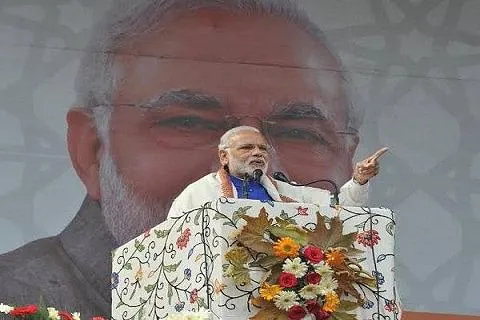Girdhari Lal Raina
The NDA government headed by Prime Minister Narendra Modi has completed its 9th year in office. Various aspects of this period from 2014 to 2023 are being discussed throughout the world. Everyone is evaluating the performance of the government and leadership of Narendra Modi from her/his point of view.
Understanding the impact of the Modi government and its handling of Jammu Kashmir in general and Kashmir in particular is also deliberated at various levels. But for a small section of people, mostly from the opposition political parties, everybody appreciates the change that has taken place on ground for good. Kashmir has graduated from an environment of conflict to a milieu of concord, harmony and reconciliation, say observers.
What used to be unbelievable just a decade ago has taken shape on ground. Developmental activities, more so in case of infrastructure, have amazingly materialized already. So is the case with almost every other field of human activity.
Conceivable harmony
The most plausible transformation that has taken place in Kashmir is the viability of peace. Having systematically and in a planned manner invested in amity, people now believe it to be possible to come out of the vicious circle of death and destruction. All this seemed to be a distant dream just a few years ago.
Earlier violence & terrorism was considered to be fait accompli. Lives of the common man got adjusted accordingly. Even political leaders got accustomed to it and their narrative became part of the problem. It soon became an industry and conflict was dressed up for economic and other material gains. Those who had no economic or other ambitions were silenced by the fear of gun.
Terrorism and terrorist violence became the identity of the place. Religious minority was unable to sustain the onslaught, hence were forced out of their homes and hearths. Justice was a far cry. Discrimination between & within regions, communities and voiceless was the order of the day. Merit became a disadvantage. Governance, by and large, was appropriated by anti-social and anti-national elements. Net result was suffering for everyone.
With the introduction of zero tolerance against terrorism and SABKA SAATH SAB KA VIKAS SAB KA VISHWAS as policy approach, a period of hope, confidence and expectations ushered in. This alteration gained momentum after historic changes of August 2019 that removed legal and constitutional obstacles. Peace, progress, Development and harmony became the new mantra. Violence and terrorism became non -rewarding. In fact even supporting such activities invited the wrath of law enforcement agencies. Common people felt encouraged and supported changes with an open heart. Tourism started regaining its lost position in the identity of Kashmir.
Aspirations re-emerge
Natural consequence of peace, harmony and policy shift was the re-emergence of aspirations of the population, in particular that of youth. Suppressed ambitions and desires began to sprout again. Government at helm of affairs not only encouraged the turn of events but actively facilitated movement forward by its plethora of schemes fashioned in a customised manner. Skill India, Digital India, Khelo India and others like MUDRA and major push to the start-up ecosystem that saw India rank as 3rd largest start-ups ecosystem globally with nearly 83, 000 recognized start-ups and with over 100 unicorns, valued at 332.7 billion dollars.
In the field of medical education, the number of UG medical seats has increased by 75 per cent, from 51,348 to around 90 thousand since 2014. PG medical seats have also seen 93 per cent jump from 31,185 to more than 60 thousand in the last eight years. The number of universities has also increased from 720 to one thousand along with 7 new IITs and IIMs across the country.
Jammu Kashmir perhaps for the first time in its recent history became an integral part of this journey.
Infrastructure Development
During nine years of the Modi government, India as a whole witnessed fast-paced infrastructure development in all sectors. Infrastructure has been put at the front and centre of its development agenda. Over 53000 kms of National highways were added with rural road connectivity increasing to nearly 99% coverage through the Pradhan Mantri Gram Sadak Yojana. The speed of highway construction has reached 37km per day.
Indian railways also witnessed a massive capacity expansion through line doubling and electrification and the Vande Bharat Express, India’s first indigenous Semi High-Speed trains, is a major ‘Make in India’ success story. 15 Vande Bharat trains are already operational and 400 Vande Bharat express trains are to be manufactured in the next three years.
In the last nine years, the metro rail projects have reached 20 cities. In the aviation section steps were taken to make it affordable and accessible through the Udan project. 74 new airports have been built and operationalized in the last 9 years. Further 111 waterways were declared as National Waterways.
The country also witnessed major constructions during this period like the World’s highest railway bridge, the Chenab Bridge and the World’s longest highway tunnel, the Atal Tunnel.
The story does not end here. This in fact is the beginning of a new era. An era of blissful peace, harmony between communities and participatory involvement of citizens for not only the betterment of Jammu Kashmir but nation and humanity as a whole. This however requires common people to realise their responsibility in strengthening the leadership of Prime Minister Narendra Modi.
Girdhari Lal Raina is a former MLC and spokesperson of BJP JK-UT
Disclaimer: The views and opinions expressed in this article are the personal opinions of the author. The facts, analysis, assumptions and perspective appearing in the article do not reflect the views of GK.






